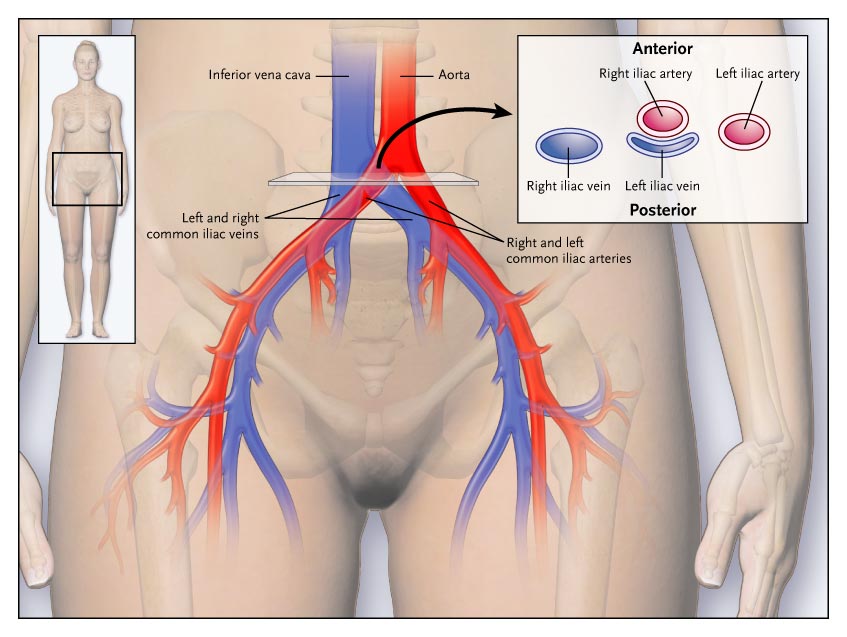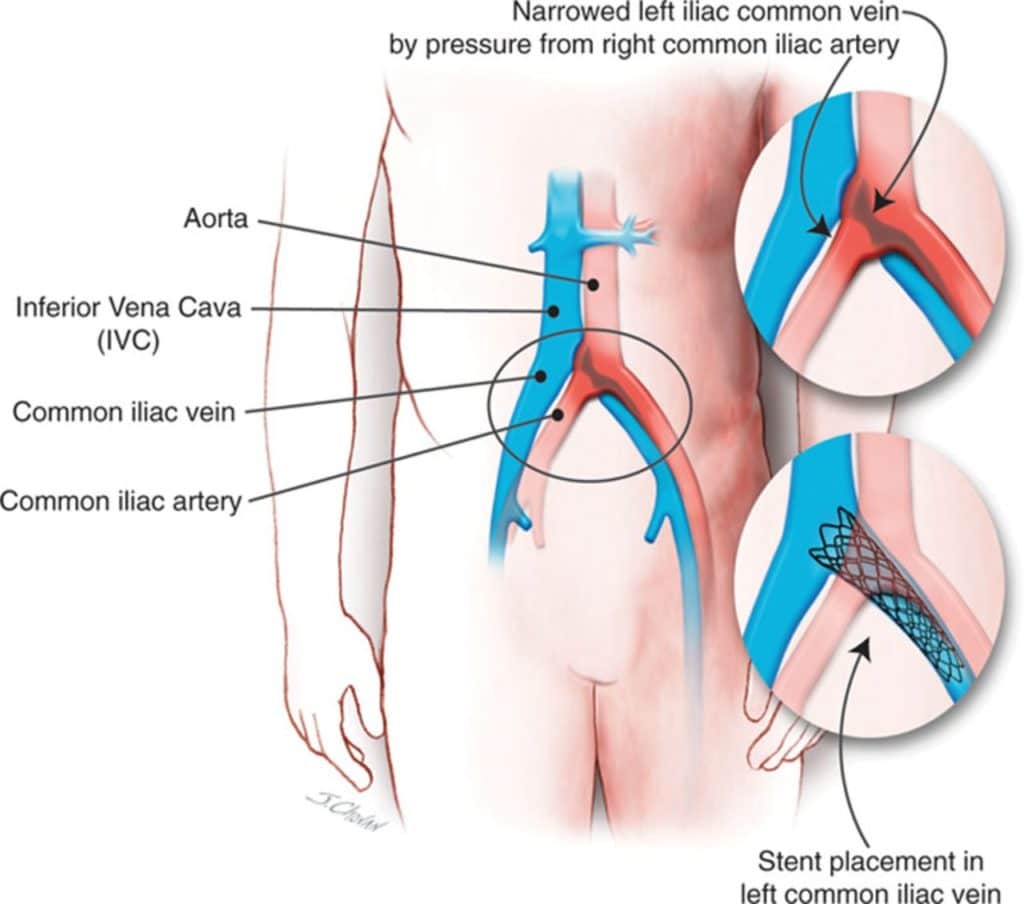What Is May-Thurner Syndrome?
Your blood vessels transmit blood to various parts of your body. The arteries carry the blood away from the heart while the veins bring it back. At times, your veins and arteries can cross over one another. In most cases, that is not a big problem. However, if you have a condition called May-Thurner syndrome, things can get complicated.
Also known as Cockett syndrome, May-Thurner syndrome can adversely affect two key blood vessels in your legs. In addition, the syndrome can make you more susceptible to a deep vein thrombosis (DVT) in the left leg. The condition affects the right iliac artery, which is responsible for carrying blood to your left iliac vein and to your right leg. The left iliac vein brings blood towards your heart from your left leg.
If you have May-Thurner syndrome, your right iliac artery will squeeze your left iliac vein whenever they cross one another in the pelvis. Due to this pressure, blood will not be able to flow as freely as needed through your left iliac vein and because of the syndrome, you are more likely to have a DVT in the left leg.
Keep in mind that a DVT is a kind of blood clot which can be extremely serious. It can block the flow of blood in your leg and also break off, causing a clot in the lung. This condition is known as a pulmonary embolism, and it can be life-threatening.
Causes and Prevalence of the May-Thurner Syndrome
Note that the May-Thurner syndrome is usually random. It is not present in your genes; so you cannot get it from your parents. It is caused when your right iliac artery gets on top of and puts pressure on your left iliac vein located in your pelvis.
Although the crossover of the blood vessels is very normal, in a few cases, these vessels are positioned in such a manner that your right iliac artery presses and squeezes your left iliac vein against your spine. The additional pressure causes the opening to narrow, which could also lead to scars in your vein. Doctors and medical professionals are not certain what causes this.

It is difficult to estimate how many individuals have May-Thurner syndrome as it often does not have any symptoms. Deep vein thrombosis relating to May-Thurner syndrome, however, is usually more prevalent in women who are between twenty and forty years old, particularly after a pregnancy or subsequent to extended periods of inactivity.
Symptoms of May-Thurner Syndrome
It is likely that you will not even know that you have May-Thurner syndrome unless you have a DVT. You may experience swelling or pain in your leg, but often, there are no warning signs. That being said, with a deep vein thrombosis, your left leg might show several symptoms like:
- Tenderness, heaviness or throbbing
- Change in skincolor, your leg will look more purple or red than usual
- Pain that feels similar to charley horse or a cramp
- Swelling
- Skin that is warm to touch
- Veins that appear much larger than normal
DVT due to May-Thurner syndrome may also trigger venous insufficiency. This can make it more difficult for the veins to carry blood back to the heart.
In case DVT breaks off to form a clot in the lungs, you may:
- Experience chest pain
- Cough up blood
- Breathe faster than usual
- Pass out
Diagnosis of May-Thurner Syndrome
A majority of patients aren’t usually diagnosed with May-Thurner syndrome till they develop deep vein thrombosis. The lack of symptoms also make May-Thurner syndrome difficult for doctors to accurately diagnose the symptoms.
For making a diagnosis, your doctor would typically start by administering a physical exam. He or she might also use a few of these imaging tests in order to help them make the diagnosis:
- CT scan
- Ultrasound
- Venogram
- MRI scan
Treatment of May-Thurner Syndrome
In most cases, the May-Thurner syndrome needs treatment only when it starts to reveal symptoms. Your doctor may prescribe you blood thinners in case you have a blood clot. Blood thinners are typically used for the treatment of DVT. They prevent the formation of new clots and keep your existing clots from getting bigger. These medications are also known as anticoagulants.
That being said, blood thinners might not be enough in some cases. Also, in some situations your doctor may deliver a clot-busting medication through a catheter directly into your vein near the blood clot. Clot busters are used for the treatment of more serious clots. The clot may take anywhere from a couple of hours to several days to dissolve. This treatment is also called thrombolytic therapy.
At Precision VIR, we are experts in thrombolytic therapy and also in determining if a minimally invasive surgical procedure is the correct therapy.
The following minimally invasive procedures are common:
Stent and Angioplasty
This is an effective treatment option for May-Thurner syndrome. Your doctor will first use a small balloon for expanding your left iliac vein. Then he will place a small mesh tube known as a stent in your vein to make sure it stays open and blood could flow freely. Keep in mind that the balloon will be deflated and taken out; however, the stent will stay in place.

Vena Cava Filter
The filters help keep blood clots from reaching your lungs from your leg if you cannot take blood thinners for some reason or they do not work effectively for you. You doctor will insert a catheter into a large vein present in your groin or neck, and then it will be inserted into your inferior vena cava; this is the largest vein. Although vena cava filters can prevent clots from reaching your lungs, they cannot stop the formation of new clots.
The minimally invasive surgeries performed by Precision VIR doctors to treat May-Thurner syndrome are performed on an outpatient basis, which means you may be able to go home the same day after surgery. You will resume your normal activities within just a couple of days to one week.
Your doctor would instruct you on how frequently you have to follow up. In case you had angioplasty and have a stent, it is likely that you will require an ultrasound check usually a week after your surgery along with regular monitoring after that.
Schedule an Appointment to Learn More
At Precision VIR, we are fully equipped to provide the care necessary to diagnose and treat May-Thurner Syndrome. Call us at 214-382-3200 to schedule a consultation or complete the form below.
Precision VIR serves the DFW area including Dallas, Fort Worth, Carrollton, Richardson, Garland, Mesquite, Highland Park, University Park, Park Cities, Allen, Plano, Frisco, McKinney, Arlington, Irving, Grand Prairie, Farmers Branch, Denton, Lewisville and all of North Texas.
This information is not a substitute for professional medical advice. Prior to starting any new treatment or questions regarding a medical condition, always seek the advice of your doctor or other qualified health provider.
Sources:

